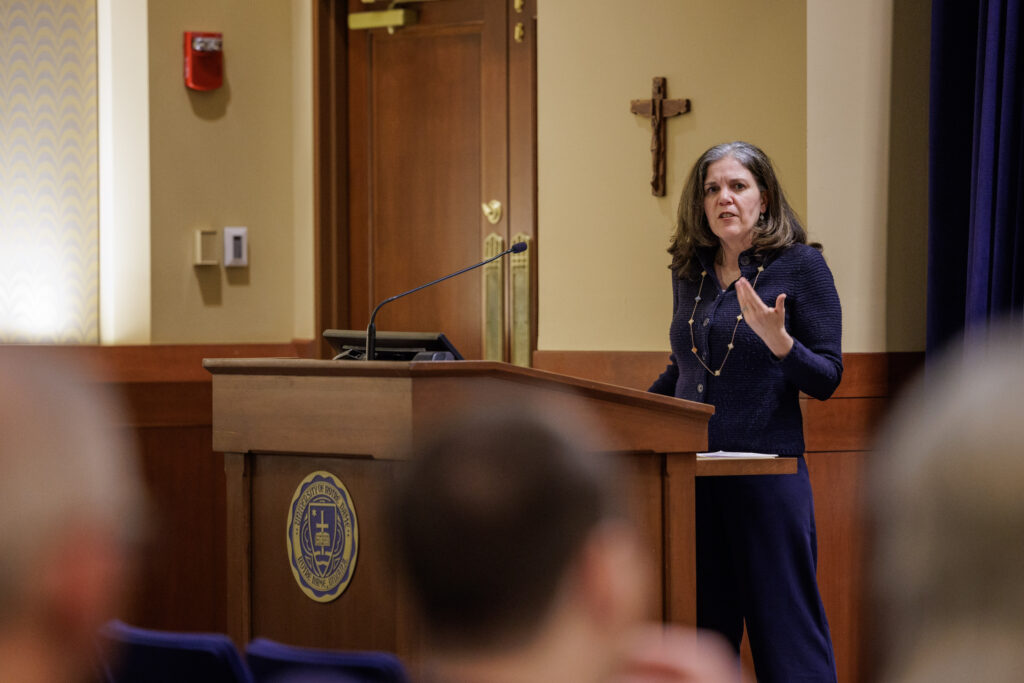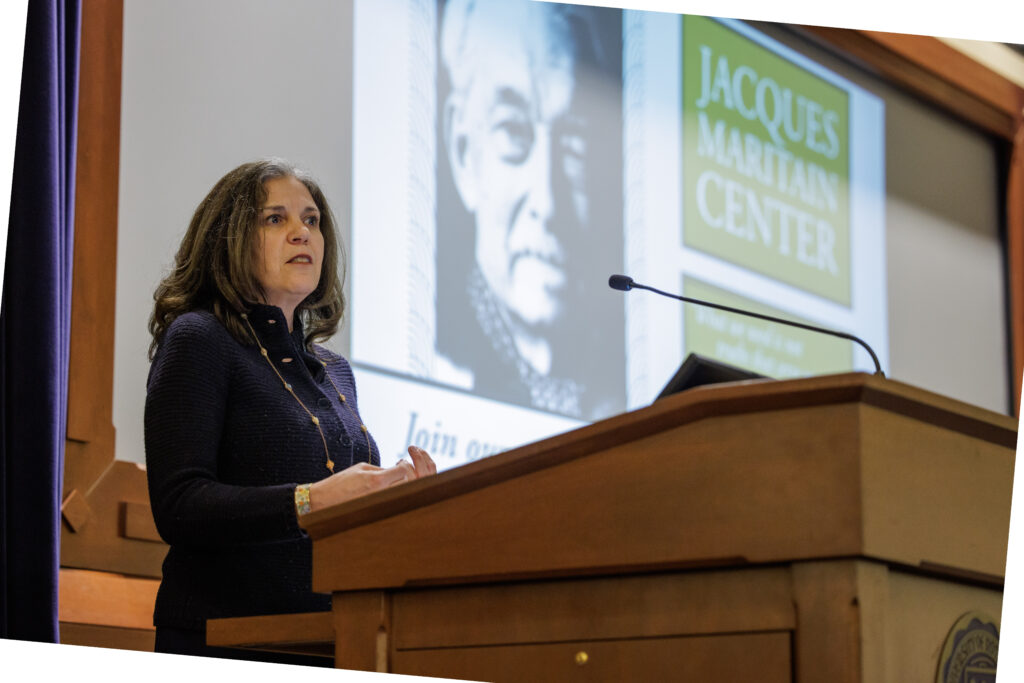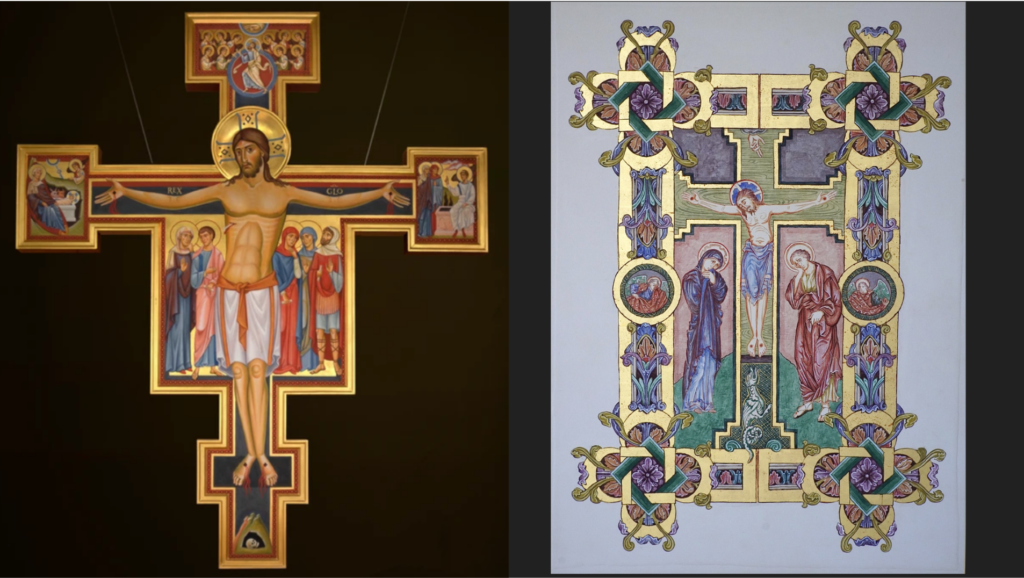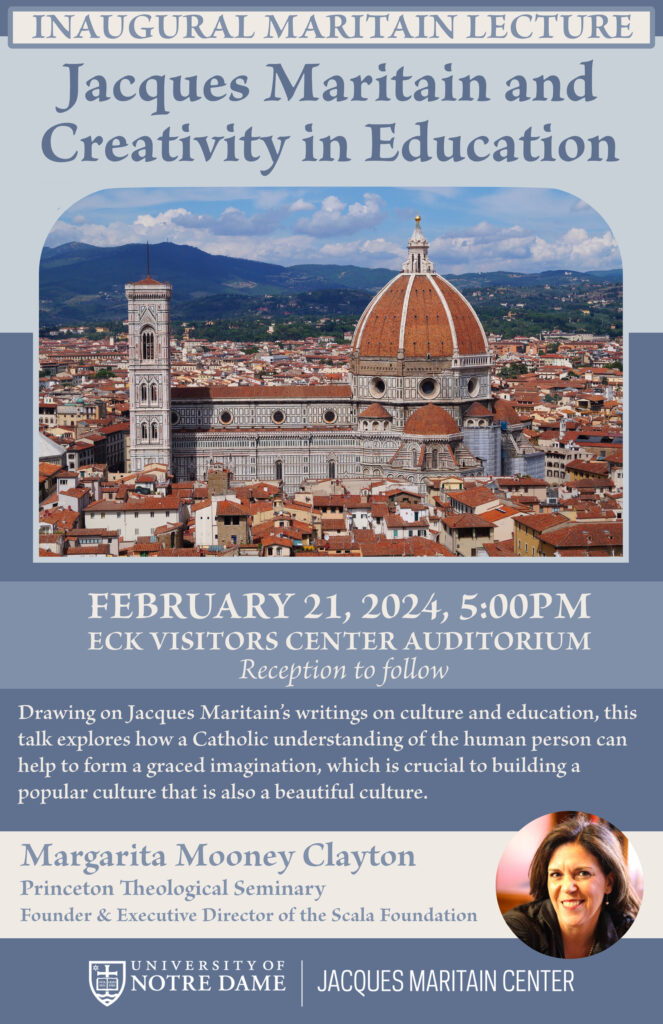Here is a summary of the main points from the Inaugural Maritain lecture I delivered on February 21, 2024, at the University of Notre Dame. The Jacques Maritain Center hosted this talk. The text below is presented in bullet point form. The video recording of the lecture itself can be seen here:
Key quote: “Artistic creation does not copy God’s creation, it continues it.” (Jacques Maritain, Art & Scholasticism)

Romantic Views of Creativity
– There is a tension in education between individual expression/authenticity and groupthink/thoughtless imitation. Students want to “find themselves” creatively/be unique but also fit in.
– Creativity is often seen as pure self-expression without universal principles or tradition. This romantic view neglects the need for discipline and virtue to develop creativity properly.
Contrast with Christian Tradition: Art as Participation in God’s Creativity
– The Christian view sees creativity as participation with God. Art manifests forms and elevates nature.
– We need tradition and virtue to develop creativity properly. Imitation leads to new creation, not slavish copying.
We need to worry about the “hindered imagination,” which is cut off from reason and cosmic harmony, blocked by bad images, or driven just by passions. A graced imagination is key to education.
– We need to recover an understanding of creativity as building on tradition, not just breaking from it. Imitation can lead to participation and new creation, not just slavish copying.

Art Imitates Nature & Continues God’s Creative Work
For Aquinas and Maritain, art imitates nature by manifesting forms and radiating splendor. Imitation elevates nature through virtue and intellect, giving art a principle of universality.
– Following Aquinas, Jacques Maritain argues that art does not imitate by reproducing but by operating like nature – having a vision and using principles to create something new. Mastery of form yields new content.
– For Aquinas, art elevates nature by manifesting forms and radiance. The delight comes from the truth it represents, not just copying.

Applications to Education, Liturgy, and the Fine Arts
– Education should aim to feed the imagination gracefully, connecting it to reason. Students need to encounter things worth imitating.
– Science education should move from sensations to principles: observing nature and discerning order.
– The arts should balance tradition and innovation – mastering form and applying those techniques anew.
– Practices like nature walks, memorization (of poems), chanting psalms, and copying masters in art help connect imagination to reason and wisdom. Copying masters in art and composition helps students discern techniques and principles. Mindful copying can be part of a dynamic cycle of creativity and craft.
– Liturgy and sacraments retune imagination to grace and cosmic harmony. The liturgy of the hours is a model to revive.
– Education must link imagination and reason through practices like memorization, translation, and chanting psalms. This connects embodied senses to abstract principles.
– Silence and contemplation are key to letting students connect their experiences to principles and discern wisely. We must counter frenetic distraction. This is not the silence of mindfulness or yoga—it’s the pregnant stillness of contemplating God, such as through the liturgy.

Teachers as Exemplars
– Students intuitively know imitation leads to participation. Students need moral exemplars to imitate, not just credentials or social belonging. Exemplars demonstrate intellectual and spiritual virtues in action. They spark students’ own creativity.
– Students imitate teachers, even unconsciously. Teachers must acknowledge their responsibility.
– Teachers assist learning by embodying virtues and offering models worthy of imitation. This allows students’ imaginations to be formed and, in turn, feed creativity with dignity. Teachers assist learning by embodying intellectual and spiritual virtues. They provide models to spark students’ own creativity.
– Families and churches, not just schools, must raise up creatively grace-filled young people open to truth and wonder.
Key Quotes
Romantic view of Art
– “Not art and artworks make the artist, but feeling and inspiration and impulse.” (F. Schlegel lived in Germany from 1772 to 1829.
– “Poetry is passion.” (Wordsworth, “Note to the Thorn” in LB: 136). Lived 1770-1850
– “All good poetry [originates in] the spontaneous overflow of powerful feelings.” (Wordsworth, Preface to Lyrical Ballads (1800), paragraph 26, in LB)
Christian View of Art
In Art & Scholasticism, Maritain writes:
– “The ancient maxim ars imitatur naturam, does not mean: ‘art imitates nature by reproducing it,’ but rather “art imitates nature by proceeding or operating like nature, ars imitatur naturam IN SUA OPERATIONE.’”
– “What is required is not that the representation exactly conform to a given reality, but that through the material elements of the beauty of the work there truly pass, sovereign and whole, the radiance of a form — of a form… But if the delight in the beautiful work comes from a truth, it does not come from the truth of imitation as reproduction of things, it comes from the perfection with which the work expresses or manifests the form, in the metaphysical sense of this word, it comes from the truth of imitation as manifestation of a form. Here we have the formal element of imitation in art: the expression or manifestation, in a work suitably proportioned, of some secret principle of intelligibility which shines forth. It is upon this that the joy of imitation bears in art. It is also what gives art its value of universality.”
– “Nature is thus the first exciter and the first guide of the artist, and not an example to be copied slavishly.”
– “The work of art has been thought before being made, it has been kneaded and prepared, formed, brooded over, ripened in a mind before passing into matter. And in matter it will always retain the color and savor of the spirit.”
Fr. Bradley T. Elliott, O.P. The Shape of the Artistic Mind
– “For St. Thomas, while both are virtues of the practical intellect, prudence is recta ratio agibilium, right reason about things done, whereas art is recta ratio factibilium, right reason about certain works to be made.”
– “Art and morality are two aspects of the human participation in the reason and creativity of God. Art and morality are both ways that the humans imitate their divine creator.”
– “The two practical virtues of prudence and art both bring, in two different ways, the irrational parts of the cosmos into the governance of reason and promote it unto a greater share of Divine Providence.”
Ioana Beleca, The Illustrated Word, Dappled Things 2024
“Mindful copying is like deciphering a code, a way of understanding not only the technical aspects of an artist’s work, but how artistic decisions impact meaning and how successful the artist ultimately is in communicating it.”

Sister Thomas More Stepnowski, The Training of the Imagination in the Published Works of Conrad Pepler, OP and Gerald Vann, OP
(see also her article on the formation of the imagination in Church Life Journal)
– “The ‘hindered’ imagination is derived from impeditus which is used by St. Thomas and describes the inability to form fully. The word “hindered” acknowledges that the imagination is neither completely obstructed nor a vacuum of nothingness, but that the interaction between the imagination and the other faculties is retarded. this can be either offering minimal images to the reason or unruly, driven by passions..a hindered imagination is a fundamental break with reality, a loss of common sense.”
– “The ‘graced’ imagination is derived from gratia but St. Thomas often uses additional terms, such as divine ray, in describing God’s action upon the imagination. The ‘graced’ imagination is formed by divine intervention and acts by healing and elevating the imagination (ST I, 12, xiii)…This looks like a ‘wholeness of vision.’”
Tyler Graham, Theology of Mimesis and Freedom in Catholic High School Teaching: A Girardian Interpretation of Msgr. Luigi Giussani’s Risk of Education (forthcoming)
“Romanticism and totalitarianism are two sides of the same coin of disoriented mimesis: the romantic imitates a desire for uniqueness, and the totalitarian follows the crowd in ideology.”
“Thus, the mastery of form yields the production of content (and not vice versa, as the Romantics might say).”

From the Ioana Belcea | Jacques Maritain | Jacques Maritain Centre | James McCrery | Margarita Mooney Clayton | Martin Earle | Notre Dame University | Picasso series
View more Posts